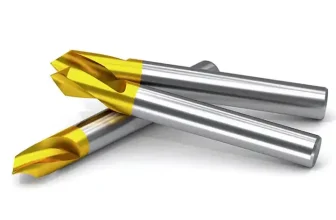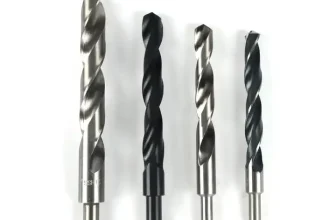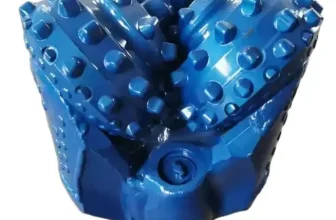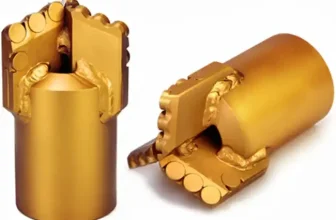A Forstner Bit, renowned in the sphere of woodworking, is a
specialized drill bit used to bore precise, flat-bottomed holes in wood.
Unlike other common bits, a Forstner Bit maintains its precision even at
an angle or through various layers of wood, creating a clean finish
without chipping or splintering. This powerful tool plays a pivotal role
in woodworking projects that require precision and finesse. It is named
after Benjamin Forstner, its inventor, who paved the way for a new era
of woodworking with his ground-breaking innovation. This tool is highly
praised for its superior quality of cut, versatility, and contribution
to complex woodworking tasks.
Its importance and
usage in woodworking
Forstner bits, in the context of woodworking, hold an incredibly
vital role. They have fundamentally changed the way artisans and
hobbyists work with wood, making the creation of precise and clean holes
a straightforward process. Due to their unique design, Forstner bits
allow woodworkers to drill with a high degree of accuracy, consistently
creating flat-bottom holes, something that standard drill bits do not
offer.
The Forstner bit’s design also enables it to drill at any angle,
further increasing its utility. Its usage extends to making pocket
holes, overlapping holes, or holes on the edge of the material—all with
much more precision than counterparts. The versatility, accuracy, and
clean results that a Forstner bit delivers make it an indispensable tool
in any woodworking project. The potential of a Forstner bit’s
contribution is considerable, and understanding its functions is crucial
for any individual working with wooden materials.
History of Forstner Bits
Invention and origin
The Forstner bit, named after its inventor Benjamin Forstner, made
its first appearance in the woodworking scene back in 1869. As an
American gunsmith with a keen eye for precision tools, Forstner
perceived a need for a bit that could drill precise, flat-bottomed
holes, a unique quality that became a trademark of his invention.
Dealing with the limitations of then available drilling tools, he
patented a bore that could produce holes without tearing the wood,
chipping it or leading it to destructive tear-out.
This novelty immediately captured the attention of many craftsmen as
it allowed them to execute complex and neat woodworking tasks with
greater ease. In the patent, Forstner wrote that his bit was “a new and
useful improvement in bit-stocks to bore out wood for any purpose where
a clean cut is required.” Indeed, his invention revolutionized the
woodworking industry, providing a new kind of tool precision that hadn’t
been seen before.
The success of Forstner’s innovation lies in its unique design that,
even after more than 150 years, still remains the choice for
professionals and hobbyists alike. Such is the legacy of Benjamin
Forstner’s invention; a milestone in woodworking history that continues
to influence the craft to this day.
Evolution over the years
Forstner Bits have seen significant evolution since their creation in
the mid-19th century. Initially, they were quite simple and composed
mainly of high-carbon steel, which required frequent sharpening. The
versatility of these tools, however, made them an instant hit among
woodworkers and artisans.
In the early 20th century, Forstner bits started to be made from
high-speed steel, which offered improved durability and longevity. This
was a game changer as it reduced the frequency of replacements and
enhanced their appeal to professional carpenters.
Then, in the latter part of the century, manufacturers started adding
various coatings to the bits to improve their performance further. For
example, some bits received a titanium nitride coating which drastically
increased their hardness, allowing the bit to both stay sharp longer and
resist heat better during operation.
In recent years, the design of Forstner bits has been refined to
improve their speed and efficiency. Many of the newer models feature a
serrated edge design, with small teeth cut into the outer rim of the
bit. This allows for faster material removal and cutting speeds,
reducing the time and effort required for woodworking projects.
So, from the advent of high-carbon steel to high-speed steel, to the
inclusion of different coatings, and finally the advancements in design,
Forstner bits have shown a dynamic evolution in their journey, tailored
to meet the ever-changing needs of woodworkers.
Different Parts of a Forstner
Bit
Element explanation
Forstner bits are recognized for their distinctive appearance
characterized by a few key elements. Understanding these components can
be important to utilizing them effectively.
At the business end of the bit, we have the center spur or guide
point. This is a small piece of the tool that leads the direction of the
drill while keeping it steady. The center spur sinks into the wood
first, enabling the user to control the positioning of the hole with
precision.
Ideally concentric to the center spur are two cutting edges. As the
name implies, they are responsible for the cutting action, slicing
through the wood as the tool rotates. They are usually quite sharp and
carve out a neat, clean hole.
These cutting edges are preceded by a circular rim. This rim is meant
to guide the cutting edges as they work their way into the wood,
ensuring that the hole remains round and true. It’s the rim that
determines the final diameter of the hole that you’re drilling.
Overall, the Forstner bit looks rather like a small, metallic
doughnut on a stick, when seen from above. The ‘stick’ is called the
shank. It is the part that is attached to the drill press or handheld
drill.
The body is the main part of the bit and it connects all the
components mentioned above. Depending on the bit design, the body can
either be solid or have large, sawdust-removal openings, which prevent
the bit from getting clogged with waste material.
Understanding these elements’ roles can help you better apprehend
Forstner bit functionality and use.
Functionality of each part
The Forstner bit is comprised of several uniquely designed parts,
each playing a pivotal role in its performance.
At the center of its design is a small nub referred to as the pilot
point. This is the part that first comes in contact with the wood,
helping the bit stay on course and resulting in precision in hole
drilling. Directly around the pilot point you’ll find the cutting edge.
This is where real action begins. The exceptionally sharp edge radially
cut through the wood, creating smooth sides and ensuring clean exit.
Next up is the rim, encircling the cutting edge. Comparable to the
circumference of a circle, the rim’s diameter determines the diameter of
the drilled hole. It effectively guides the cutting edge and ensures a
consistently circular drill, regardless of the hole’s width.
Lastly, there’s the chip space and shank. The chip space, located
behind the cutting edge and rim, plays the crucial role of removing the
material that has been cut away as the bit rotates, thus preventing any
clogging up. The shank meanwhile, is the part of the bit that’s fastened
into a drill’s chuck. It is usually hexagonal or round and can be of
varying sizes to fit different chucks.
Understanding the function of each part contributes to enhanced
efficiency, safety, and maintenance of the Forstner bit.
Types of Forstner Bits
Brief
explanation and examples of different types
There are several types of Forstner bits, each designed with specific
features to cater to different woodworking needs.
The first type is the Rim-guided bit, also referred to as a
knife-edge bit. Each slice is shaped like a knife edge, allowing for
precise calculations and clean cuts. This type of bit is perfect for
drilling partially overlapping holes or holes on the edge of the wood
without any fear of the bit skidding away.
The next type is the center-guided bit, which offers additional
stability. This bit has a point at the center which helps guide the
drilling process. It’s ideal for drilling straight holes and works well
even with unsteady hands.
Then, we have the saw-toothed bits. These are specifically designed
for cutting larger holes. Traditionally, Forstner bits struggle with
heat buildup when working on larger holes, but the saw-toothed bits
manage heat better. They are slower but their efficiency for larger
holes is noteworthy.
Multi-spur bits own giant sharp teeth that cut aggressively into the
wood. They’re intended for use in a drill press and recommended for
cutting hardwoods or exotic woods, where other bits might struggle.
Wave cutter Forstner bits, on the other hand, are a newer bit design
with a wavy rim. They provide a much cleaner exit hole and handle
angles, overlapping holes, and wood surfaces with verve.
Lastly, the Continuous edge or serrated edge bits are the newest
designs available. These bits feature a serrated cutting edge designed
to bite into the wood, requiring less force and generating less
heat.
Each of these Forstner bits has a specific purpose, and understanding
which type to use can significantly optimize your woodworking tasks. The
right bit can make the difference between a rough, uneven hole and
clean, precise woodworking.
Understanding their
specific usages
Forstner bits come in various types, each designed with specific
usages in mind.
The Saw-Tooth bits, for example, are most effective for drilling
larger holes in all types of wood. They remove wood quickly and are also
an excellent choice for drilling through knotted material where a
standard Forstner bit may struggle.
Rim-guided bits are particularly suited for drilling partial arcs or
holes on the edge of material, thanks also to their open side. Plus,
their guided rim accuracy makes them invaluable while doing precise
work.
Wave cutter Forstner bits, on the other hand, are fantastic for
drilling holes with ultra smooth sides, maintaining a constant cutting
speed and optimum control. Their wave-like edge helps reduce heat
buildup, making them suitable for extended drilling sessions.
Then there’s the Multi-toothed bits. These make less contact with the
wood and thus generate less heat. They’re a great choice where burnout
is a risk, such as when drilling very dense woods.
Lastly, the Continuous rim bits offer an excellent balance between
speed and finish quality. They’re ideal for drilling medium-sized holes
and for users who need a versatile bit for different woodworking
projects.
Each type of Forstner bit has its specific usage and choosing the
right one depends on the exact nature of your task. And regardless of
the type, all Forstner bits can drill flat-bottomed holes, which is not
achievable with a standard drill or spade bit. Thus, understanding their
specific usages is crucial to perform an efficient and effective
woodworking task.
How a Forstner Bit Works
Drilling process explained
A Forstner bit works by fashioning a precise and clean hole in the
wood, the process of which is quite remarkable. The centring tip of the
bit is the first part to touch the wood when drilling commences. This
tip aids in keeping the bit in place while you start drilling,
preventing any unnecessary skidding or moving that could cause
imprecision.
Once the bit starts to penetrate the wood, the circumferential edge
known as the cutter rim comes into play. This rim bores into the wood
simultaneously as the centring tip delves deeper, creating an incredibly
neat hole with smooth walls. The cut-out waste, also-called swarf, is
then pushed up out of the hole by the chip gullet, avoiding any
potential blockages during the drilling process.
Unlike some common drills where the entire surface of the drill
pushes through the material, the design of the Forstner bit ensures that
the rim leads the action. The remaining part of the bit, or the primary
blade, then follows and continues to clean out the remaining material.
This unique operation delivers a flat-bottomed hole which is almost
impossible with other standard drill bits.
The rate at which the drilling occurs heavily depends on factors such
as the force applied to the drill, the speed at which the drill is
operating, and the hardness or softness of the wood being worked on.
Factors affecting its
performance
The performance of a Forstner bit can be affected by a number of
factors. One of the primary elements is the type of wood it’s being used
on. Hardwood and softwood vary greatly in density, and this can
influence the bit’s speed and efficiency.
The sharpness of the bit is another crucial factor. A dull Forstner
bit won’t cut as cleanly or accurately as a sharp one, and could
generate more heat, thereby damaging the wood or even the bit over
time.
The design of the bit can also impact its performance. For example, a
bit with a wavy edge or serrated design may work differently than a more
standard design. These design features can affect the speed of cutting
and the quality of the hole.
Not to forget, the speed of the drill can significantly influence the
performance of a Forstner bit. A high-speed drill may make the bit
overheat, especially when drilling through dense materials, while a
slower speed might not provide enough power.
Lastly, operator skill level and technique play a big role. Using the
right amount of force, keeping the bit straight, and clearing out chips
and dust regularly can greatly enhance the effectiveness and lifespan of
a Forstner bit.
Applications of Forstner
Bits
Common usage in
various woodworking projects
Forstner bits enjoy versatility in a myriad of woodworking projects
due to their unique design and efficient cutting abilities. Quite
popular in the world of custom woodworking, cabinet making, and
furniture building, these unique drill bits produce clean and precise
holes which are integral in these processes.
One of the most common uses of Forstner bits is in drilling
flat-bottomed holes; something other bits like spade or twist just can’t
manage as efficiently. This becomes particularly crucial when the hole
doesn’t need to go all the way through the wood, like embedding the
heads of bolts or creating recesses for hardware installation.
When creating dowels or mortises for joinery, Forstner bits shine.
They can not only bore straight holes, but angled holes too, making them
perfect for craftsmen needing such joints in their projects. Moreover,
they can also create overlapping holes, useful in many woodworking tasks
like mortises, recesses, or when sculpting large bowls.
Forstner bits are also sought-after when minimal tear-out is
important. For instance, when a hole is needed near the edge of the wood
piece, or when drilling through veneer or thin plywoods.
Finally, due to their ability to guide themselves, Forstner bits
excel in drilling holes on irregular surfaces or through knots, where
traditional drill bits might deflected off course, proving once again,
just how invaluable they can be in various woodworking endeavors.
Ideal situations for
using a Forstner bit
Forstner bits excel in delivering precise, clean cuts in woodworking
projects and are often the top choice in various scenarios. They’re best
suited when you need to drill flat-bottomed holes, an often requisite in
furniture making and cabinetry. Forstner bits are also the go-to for any
projects that require drilling at angles or creating overlapping holes,
thanks to their design that does not wander or deflect like a standard
twist bit.
Another ideal situation is when precision is vital in your project.
Forstner bits stand out due to their ability to drill holes with great
accuracy, ensuring an upscale, finished look in your work. These bits
are also ideal for drilling through expensive hardwoods, as they
minimize splintering and chipping that lesser quality bits may
cause.
Also, in times when hole depth matters, Forstner bits come into play
as they can create shallow holes precisely. Their design offers control
over how deep the bit drills, making them perfect for projects like door
hinges or wherever a shallow, clean hole is critical.
In essence, when the requirement is for a crisp, clean, and accurate
hole – whether it be flat-bottomed, angled, or overlapping – a Forstner
bit is the answer.
Choosing the Right Forstner
Bit
Considerations before buying
When selecting a Forstner bit, you should keep a few critical
considerations in mind to ensure that you get the most suitable tool for
your needs. First, consider the size of the hole you wish to drill as
Forstner bits can range from a quarter of an inch to over two inches in
diameter. Choose a bit that is the exact size of the hole.
Next, take into account the type of material you’ll be working with.
For example, if you plan to drill into hard types of wood, it is worth
investing in high-quality, carbide-tipped bits. These are more durable
and maintain sharpness better than their high-speed steel
counterparts.
You will also want to pay attention to the shank of the bit. Ensure
it matches your drill’s specifications. Some bits are designed with a
reduced shank allowing for use with smaller chuck sizes, while others
may require a larger drill chuck.
Lastly, consider purchasing a set of Forstner bits rather than
individual ones. If you expect to be completing various projects with
different hole sizing needs, a good-quality set can be more
cost-effective and versatile.
Remember, the quality of your Forstner bit can significantly impact
your project’s outcome and safety. Therefore, though higher quality bits
may come with a heftier price tag, they prove worthy for their
durability, precision, and ease of use.
Suggestions for care and
maintenance
Regular care and maintenance of a Forstner bit is crucial in ensuring
its longevity and optimal performance. Proper storage is the first step.
After use, the bit should be cleaned of any debris and stored in a dry
place to prevent rusting. Some professionals even recommend coating the
bit lightly with an oil for further protection.
Sharpening is another core maintenance practice. Over time and with
continued use, the bit may become dull and less efficient. Regular
sharpening is necessary to keep it operating at its best. This can
either be done professionally or by using a honing guide and a diamond
paddle or honing stone. It’s important to handle this process carefully
to avoid uneven sharpening.
Lastly, remember that even the best care and maintenance cannot
salvage a tool that is not well-suited to your needs. So always consider
your specific requirements and the bit’s characteristics before making
the purchase in the first place. Regular care will then ensure that your
Forstner bit remains a valuable part of your woodworking toolbox for
years to come.
Safety Measures when
using Forstner Bits
Precautions to take
Before using a Forstner bit, it’s critical to ensure that the
workpiece is securely clamped down. Loose materials can be spun or
kicked up, posing a risk to your safety. Always double-check the
stability of your materials before you begin any drilling activity.
Another crucial safety measure is to use a drill press for
large-sized Forstner bits if available, as they can cause hand drills to
spin if they bite too deeply into the wood too quickly. Even with
smaller bits, you should always ensure to keep a steady hand and firm
footing.
Moreover, always wear proper safety gear. This includes safety
glasses to protect your eyes from flying debris and dust mask or
respirator to insulate against fine wood dust particles which can be
harmful to breathe in. If you’re working in a noisy environment or
planning for a long duration of work, wearing ear protection would also
be beneficial.
Furthermore, it’s important to make sure your Forstner bits are kept
sharp. Dull bits require more force to operate and can result in
slippage or cause the bit to break, risking injury. Regular inspection
of your bits for any signs of wear or damage is a must.
Lastly, never leave the drill running unattended and ensure it’s
completely switched off and unplugged during bit changes or when not in
use. Following these precautions can greatly enhance your safety and
result in an efficient working process using Forstner bits.
Steps to take in case of
mishaps
If any mishaps occur while using a Forstner bit, immediate action
should be taken. First and foremost, stop the drilling action. This is
crucial for preventing further damage. Switch off the power tool at once
and remove the bit from the workpiece.
If there’s an injury, assess it immediately. Minor cuts or scrapes
may just require cleaning and bandaging. However, if you’ve sustained a
more severe injury, do not hesitate to seek immediate medical
attention.
Should your Forstner bit break or become stuck in your project, don’t
try forcing it out as this could cause injury. Instead, take the time to
disassemble the drill chuck, if possible, for a safe removal of the
broken component or seek professional help if necessary.
And finally, if the bit overheats, let it cool naturally. Dipping a
hot bit into cold water for rapid cooling may cause it to become brittle
and break. Only restart your work once everything is back in place and
working correctly.
Ensure that mishaps are a learning experience. Analyze what went
wrong and think about how to avoid similar incidents in the future.
Proper training and a strong presence of mind are vital in ensuring safe
woodworking practices.
Conclusion
Recap of the
importance and usage of Forstner Bits
Over the course of this article, we have explored the importance,
usage, and various aspects of the Forstner Bit, the unsung hero of the
woodworking world. Their unique design and ability to drill
flat-bottomed holes make them an intrinsic part of any woodworker’s
toolkit. With a variety of types available, they cater to a wide range
of applications and can greatly enhance the craftsmanship of woodworking
projects. However, like any tool, they require correct and safe
handling. With a deeper understanding of their history, design,
functionality, and appropriate usage, one can fully appreciate the
immense value they bring to this artisan craft.
Encouragement for
proper use and safety.
Forstner bits are undeniably a vital tool in woodworking due to their
unique design and versatile nature. Their correct usage not only
guarantees precise and clean holes but also discourages unnecessary
damages that could belittle your final piece of work.
However, their effectiveness greatly depends on the user’s adherence
to safety protocols and proper preservation. Remember, woodworking, as
much as it’s an art, it is also a trade that requires utmost safety.
Therefore, always ensure you are using the correct bit for your project,
secure your workpiece well, and wear protective gear when at work.
Maintenance is another crucial aspect you should not overlook. A
well-maintained bit is less likely to break or cause accidents, and it
will undoubtedly serve you longer, making it a cost-effective tool.
The bottom line here is, Forstner bits are the go-to tools for any
woodworker who prizes precision, clean finishes, and versatility.
Nevertheless, let’s not forget the importance of safety measures and
proper care mechanisms. These considerations play an integral part in
not only prolonging the lifespan of these bits but also making sure your
woodworking journey is injury-free and fulfilling. Therefore, as you
strive to perfect your craft, aim to utilize your Forstner bits
correctly and safely.







